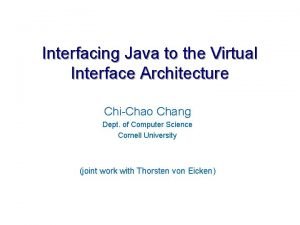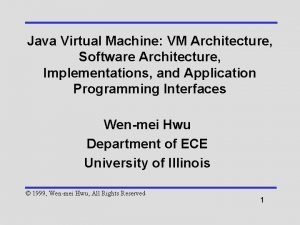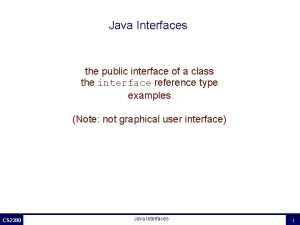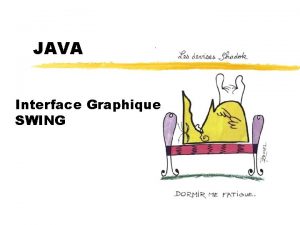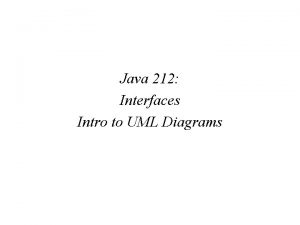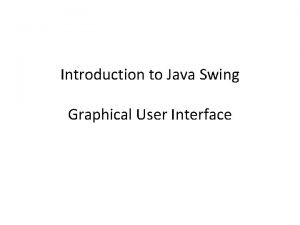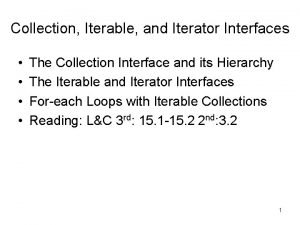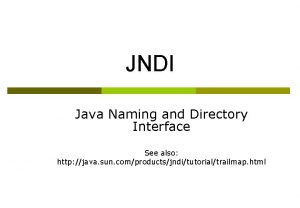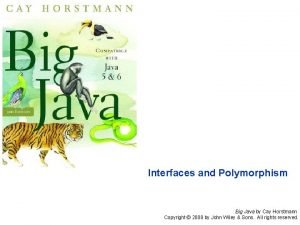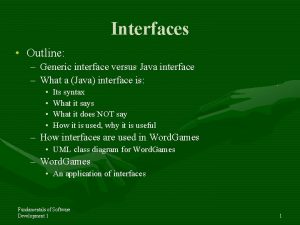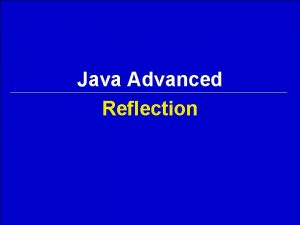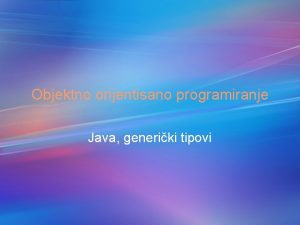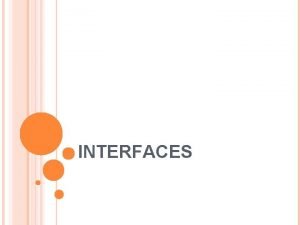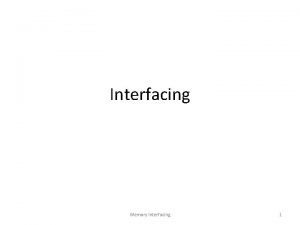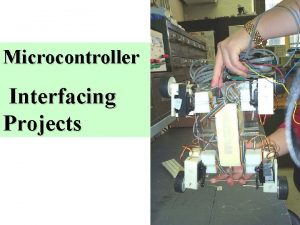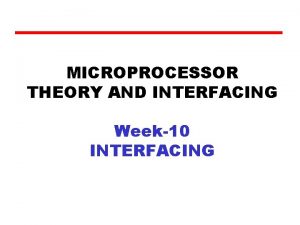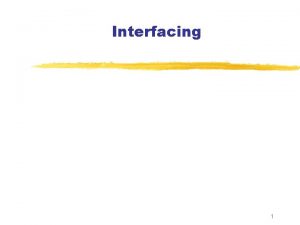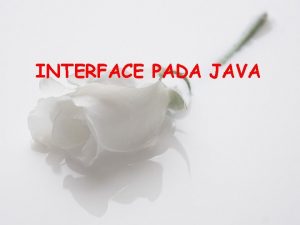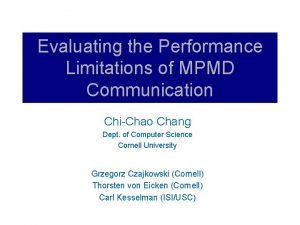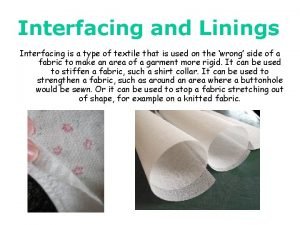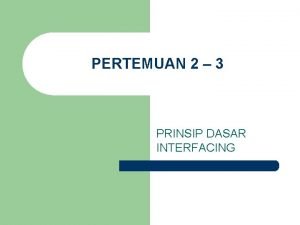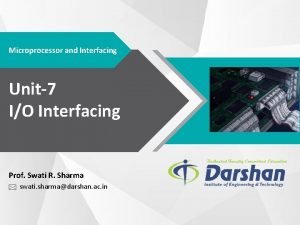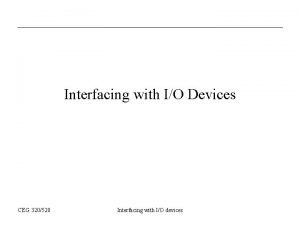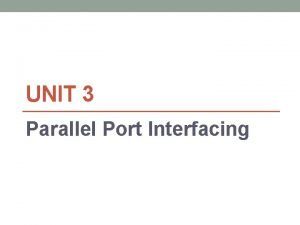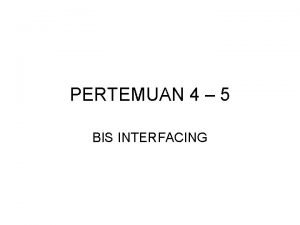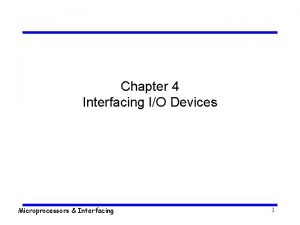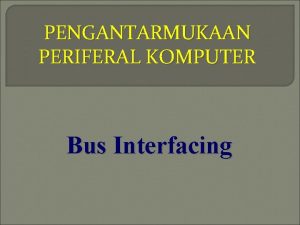Interfacing Java to the Virtual Interface Architecture ChiChao

















- Slides: 17

Interfacing Java to the Virtual Interface Architecture Chi-Chao Chang Dept. of Computer Science Cornell University (joint work with Thorsten von Eicken)

Preliminaries High-performance cluster computing with Java l on homogeneous clusters of workstations User-level network interfaces l l direct, protected access to network devices Virtual Interface Architecture: industry standard l Giganet’s GNN-1000 adapter Improving Java technology l Marmot: Java system with static bc x 86 compiler Apps RMI, RPC Javia: A Java interface to VIA 4 bottom-up approach 4 minimizes unverified code 4 focus on data-transfer inefficiencies Sockets Active Messages, MPI, FM Java VIA C Networking Devices 22

VIA and Java Application Memory VIA Endpoint Structures l l buffers, descriptors, send/recv Qs pinned to physical memory send. Q Key Points l l direct DMA access: zero-copy buffer mgmt (alloc, free, pin, unpin) performed by application l Library buffers recv. Q descr DMA Doorbells buffer re-use amortizes pin/unpin cost (~ 5 K cycles on PII-450 W 2 K) Adapter Memory management in Java is automatic. . . l no control over object location and lifetime l l copying collector can move objects around clear separation between Java heap (GC) and native heap (no GC) l crossing heap boundaries require copying data. . . 33

Javia-I Basic Architecture l respects heap separation l l buffer mgmt in native code l Vi primitive array transfers only non-blocking l l send/recv ticket ring copying GC disabled in native code Send/Recv API l byte array ref Marmot as an “off-the-shelf” system l l GC heap bypass ring accesses copying eliminated during send by pinning array on-the-fly recv allocates new array on-the-fly Java C send/recv queue descriptor buffer VIA cannot eliminate copying during recv 44

Javia-I: Performance Basic Costs (PII-450, Windows 2000 b 3): VIA pin + unpin = (10 + 10)us Marmot: native call = 0. 28 us, locks = 0. 25 us, array alloc = 0. 75 us Latency: N = transfer size in bytes 16. 5 us + (25 ns) * N 38. 0 us + (38 ns) * N 21. 5 us + (42 ns) * N 18. 0 us + (55 ns) * N raw pin(s) copy(s)+alloc(r) BW: 75% to 85% of raw, 6 KByte switch over between copy and pin 55

jbufs Motivation l hard separation between Java heap (GC) and native heap (no GC) leads to inefficiencies Goal l provide buffer management capabilities to Java without violating its safety properties jbuf: exposes communication buffers to Java programmers 1. lifetime control: explicit allocation and de-allocation 2. efficient access: direct access as primitive-typed arrays 3. location control: safe de-allocation and re-use by controlling whether or not a jbuf is part of the GC heap l heap separation becomes soft and user-controlled 66

jbufs: Lifetime Control public class jbuf { public static jbuf alloc(int bytes); /* allocates jbuf outside of GC heap */ public void free() throws Cannot. Free. Exception; /* frees jbuf if it can */ } handle jbuf GC heap 1. jbuf allocation does not result in a Java reference to it l cannot access the jbuf from the wrapper object 2. jbuf is not automatically freed if there are no Java references to it l free has to be explicitly called 77

jbufs: Efficient Access public class jbuf { /* alloc and free omitted */ public byte[] to. Byte. Array() throws Typed. Exception; /*hands out byte[] ref*/ public int[] to. Int. Array() throws Typed. Exception; /*hands out int[] ref*/. . . } jbuf Java byte[] ref GC heap 3. (Storage Safety) jbuf remains allocated as long as there array references to it l when can we ever free it? 4. (Type Safety) jbuf cannot have two differently typed references to it at any given time l when can we ever re-use it (e. g. change its reference type)? 88

jbufs: Location Control public class jbuf { /* alloc, free, to. Arrays omitted */ public void un. Ref(Call. Back cb); /* app intends to free/re-use jbuf */ } Idea: Use GC to track references un. Ref: application claims it has no references into the jbuf l l l jbuf is added to the GC heap GC verifies the claim and notifies application through callback application can now free or re-use the jbuf Required GC support: change scope of GC heap dynamically jbuf Java byte[] ref GC heap un. Ref GC heap call. Back 99

jbufs: Runtime Checks to<p>Array, GC alloc free to<p>Array Unref ref<p> un. Ref GC* to-be unref<p> to<p>Array, un. Ref Type safety: ref and to-be-unref states parameterized by primitive type GC* transition depends on the type of garbage collector l l non-copying: transition only if all refs to array are dropped before GC copying: transition occurs after every GC 1010

Javia-II Exploiting jbufs l l l GC heap explicit pinning/unpinning of jbufs only non-blocking send/recvs additional checks to ensure correct semantics send/recv ticket ring state jbuf array refs Vi Java C send/recv queue descriptor VIA 1111

Javia-II: Performance Basic Costs allocation = 1. 2 us, to*Array = 0. 8 us, un. Refs = 2. 5 us Latency (n = xfer size) 16. 5 us + (0. 025 us) * n 20. 5 us + (0. 025 us) * n 38. 0 us + (0. 038 us) * n 21. 5 us + (0. 042 us) * n raw jbufs pin(s) copy(s) BW: within margin of error (< 1%) 1212

Exercising Jbufs Active Messages II l maintains a pool of free recv jbufs l l jbuf passed to handler un. Ref is invoked after handler invocation if pool is empty, alloc more jbufs or reclaim existing ones copying deferred to GC-time only if needed class First extends AMHandler { private int first; void handler(AMJbuf buf, …) { int[] tmp = buf. to. Int. Array(); first = tmp[0]; } } class Enqueue extends AMHandler { private Queue q; void handler(AMJbuf buf, …) { int[] tmp = buf. to. Int. Array(); q. enq(tmp); } } 1313

AM-II: Preliminary Numbers Latency about 15 s higher than Javia l l synch access to buffer pool, endpoint header, flow control checks, handler id lookup room for improvement BW within 3% of peak for 16 KByte messages 1414

Exercising Jbufs again “in-place” object unmarshaling l l l assumption: homogeneous cluster and JVMs defer copying and allocation to GC-time if needed jstreams = jbuf + object stream API GC heap “typical” read. Object GC heap write. Object NETWORK GC heap “in-place” read. Object 1515

jstreams: Performance read. Object cost constant w. r. t. object size l l about 1. 5 s per object if written in C pointer swizzling, type-checking, array-bounds checking 1616

Summary Research goal: Efficient, safe, and flexible interaction with network devices using a safe language Javia: Java Interface to VIA l native buffers as baseline implementation l l jbufs: safe, explicit control over buffer placement and lifetime l l l can be implemented on off-the-shelf JVMs ability to allocate primitive arrays on memory segments ability to change scope of GC heap dynamically building blocks for Java apps and communication software l l l parallel matrix multiplication active messages remote method invocation 1717
 What is interface in java
What is interface in java Jbufs
Jbufs Java virtual machine architecture diagram
Java virtual machine architecture diagram Abowd and beale framework example
Abowd and beale framework example Office interface vs industrial interface
Office interface vs industrial interface Interface------------ an interface *
Interface------------ an interface * Java extend interface
Java extend interface Interface in java
Interface in java Interface graphique java
Interface graphique java Java interface uml
Java interface uml Java graphical user interface
Java graphical user interface Set interface in java
Set interface in java Java naming and directory interface
Java naming and directory interface Java interface polymorphism
Java interface polymorphism Interface graphique java eclipse
Interface graphique java eclipse Java final interface
Java final interface Java comparable interface
Java comparable interface Similar to
Similar to

